FNSACC601: Tax Documentation for Legal Entities - Detailed Essay
VerifiedAdded on 2023/06/15
|21
|4985
|271
Essay
AI Summary
This assignment is an essay focusing on the preparation and administration of tax documentation for legal entities, specifically addressing ethical considerations, legislative requirements, and key elements of Australian tax law. It covers topics such as conflict of interest, responsibilities of tax agents under the Tax Agent Services Act (TASA) and Tax Agent Services Regulations (TASR), government tax policy documents, and explanatory materials related to legislation. The essay also delves into critical aspects of Australian tax law concerning companies, trusts, partnerships, and sole traders, including income tax law, goods and services tax (GST), and administrative aspects of taxation. Furthermore, it describes key sources of information and taxable transactions data required for calculating taxable income, organizational policies and procedures, and relevant accounting principles for different types of legal entities. The essay provides answers to specific questions related to these topics, offering detailed explanations and insights into the complexities of tax documentation for legal entities in Australia. This document also includes assessment summary sheet and other declarations to ensure that the student has been assessed in a fair and flexible manner.
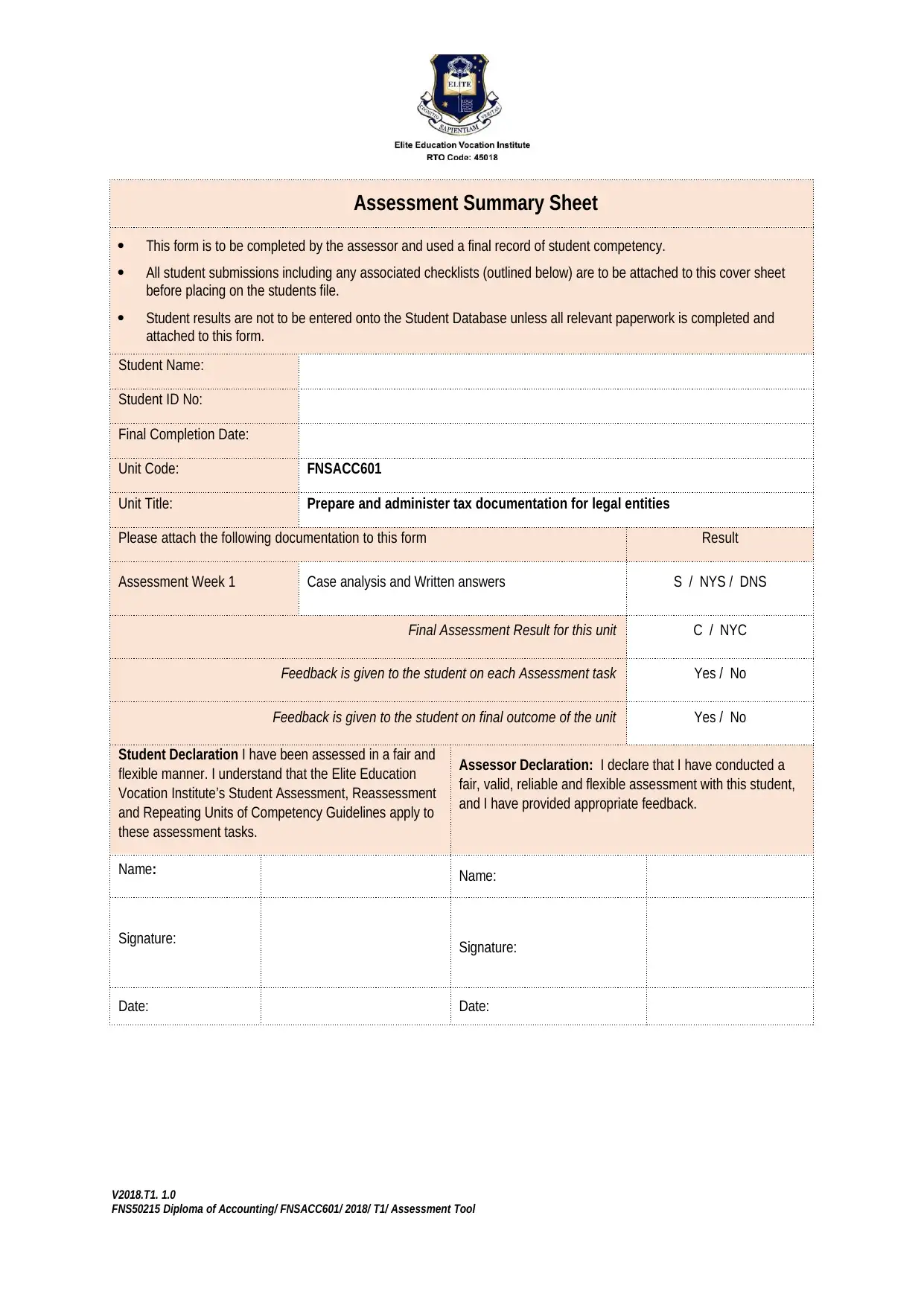
Assessment Summary Sheet
This form is to be completed by the assessor and used a final record of student competency.
All student submissions including any associated checklists (outlined below) are to be attached to this cover sheet
before placing on the students file.
Student results are not to be entered onto the Student Database unless all relevant paperwork is completed and
attached to this form.
Student Name:
Student ID No:
Final Completion Date:
Unit Code: FNSACC601
Unit Title: Prepare and administer tax documentation for legal entities
Please attach the following documentation to this form Result
Assessment Week 1 Case analysis and Written answers S / NYS / DNS
Final Assessment Result for this unit C / NYC
Feedback is given to the student on each Assessment task Yes / No
Feedback is given to the student on final outcome of the unit Yes / No
Student Declaration I have been assessed in a fair and
flexible manner. I understand that the Elite Education
Vocation Institute’s Student Assessment, Reassessment
and Repeating Units of Competency Guidelines apply to
these assessment tasks.
Assessor Declaration: I declare that I have conducted a
fair, valid, reliable and flexible assessment with this student,
and I have provided appropriate feedback.
Name: Name:
Signature: Signature:
Date: Date:
V2018.T1. 1.0
FNS50215 Diploma of Accounting/ FNSACC601/ 2018/ T1/ Assessment Tool
This form is to be completed by the assessor and used a final record of student competency.
All student submissions including any associated checklists (outlined below) are to be attached to this cover sheet
before placing on the students file.
Student results are not to be entered onto the Student Database unless all relevant paperwork is completed and
attached to this form.
Student Name:
Student ID No:
Final Completion Date:
Unit Code: FNSACC601
Unit Title: Prepare and administer tax documentation for legal entities
Please attach the following documentation to this form Result
Assessment Week 1 Case analysis and Written answers S / NYS / DNS
Final Assessment Result for this unit C / NYC
Feedback is given to the student on each Assessment task Yes / No
Feedback is given to the student on final outcome of the unit Yes / No
Student Declaration I have been assessed in a fair and
flexible manner. I understand that the Elite Education
Vocation Institute’s Student Assessment, Reassessment
and Repeating Units of Competency Guidelines apply to
these assessment tasks.
Assessor Declaration: I declare that I have conducted a
fair, valid, reliable and flexible assessment with this student,
and I have provided appropriate feedback.
Name: Name:
Signature: Signature:
Date: Date:
V2018.T1. 1.0
FNS50215 Diploma of Accounting/ FNSACC601/ 2018/ T1/ Assessment Tool
Paraphrase This Document
Need a fresh take? Get an instant paraphrase of this document with our AI Paraphraser
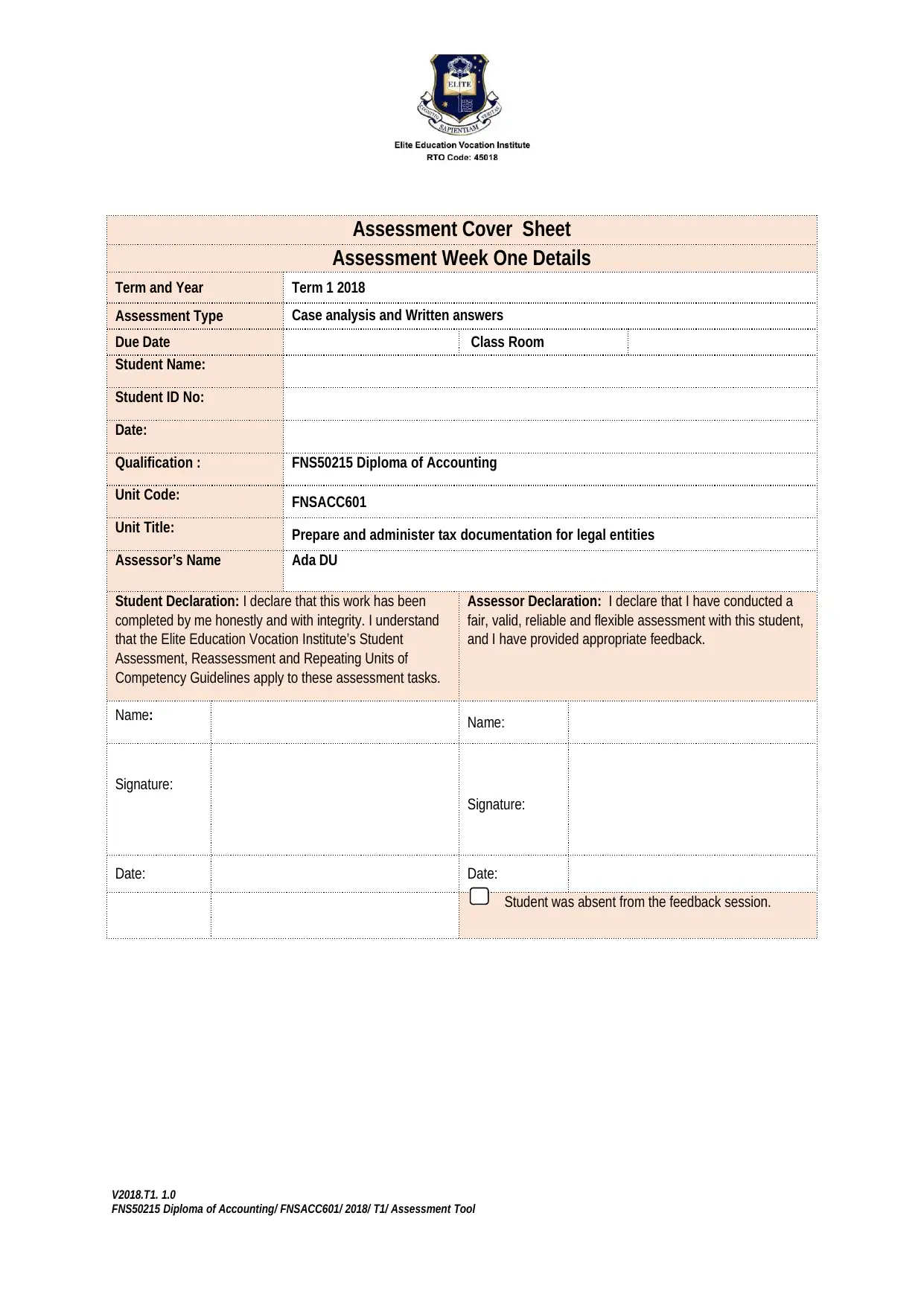
Assessment Cover Sheet
Assessment Week One Details
Term and Year Term 1 2018
Assessment Type Case analysis and Written answers
Due Date Class Room
Student Name:
Student ID No:
Date:
Qualification : FNS50215 Diploma of Accounting
Unit Code: FNSACC601
Unit Title: Prepare and administer tax documentation for legal entities
Assessor’s Name Ada DU
Student Declaration: I declare that this work has been
completed by me honestly and with integrity. I understand
that the Elite Education Vocation Institute’s Student
Assessment, Reassessment and Repeating Units of
Competency Guidelines apply to these assessment tasks.
Assessor Declaration: I declare that I have conducted a
fair, valid, reliable and flexible assessment with this student,
and I have provided appropriate feedback.
Name: Name:
Signature:
Signature:
Date: Date:
Student was absent from the feedback session.
V2018.T1. 1.0
FNS50215 Diploma of Accounting/ FNSACC601/ 2018/ T1/ Assessment Tool
Assessment Week One Details
Term and Year Term 1 2018
Assessment Type Case analysis and Written answers
Due Date Class Room
Student Name:
Student ID No:
Date:
Qualification : FNS50215 Diploma of Accounting
Unit Code: FNSACC601
Unit Title: Prepare and administer tax documentation for legal entities
Assessor’s Name Ada DU
Student Declaration: I declare that this work has been
completed by me honestly and with integrity. I understand
that the Elite Education Vocation Institute’s Student
Assessment, Reassessment and Repeating Units of
Competency Guidelines apply to these assessment tasks.
Assessor Declaration: I declare that I have conducted a
fair, valid, reliable and flexible assessment with this student,
and I have provided appropriate feedback.
Name: Name:
Signature:
Signature:
Date: Date:
Student was absent from the feedback session.
V2018.T1. 1.0
FNS50215 Diploma of Accounting/ FNSACC601/ 2018/ T1/ Assessment Tool
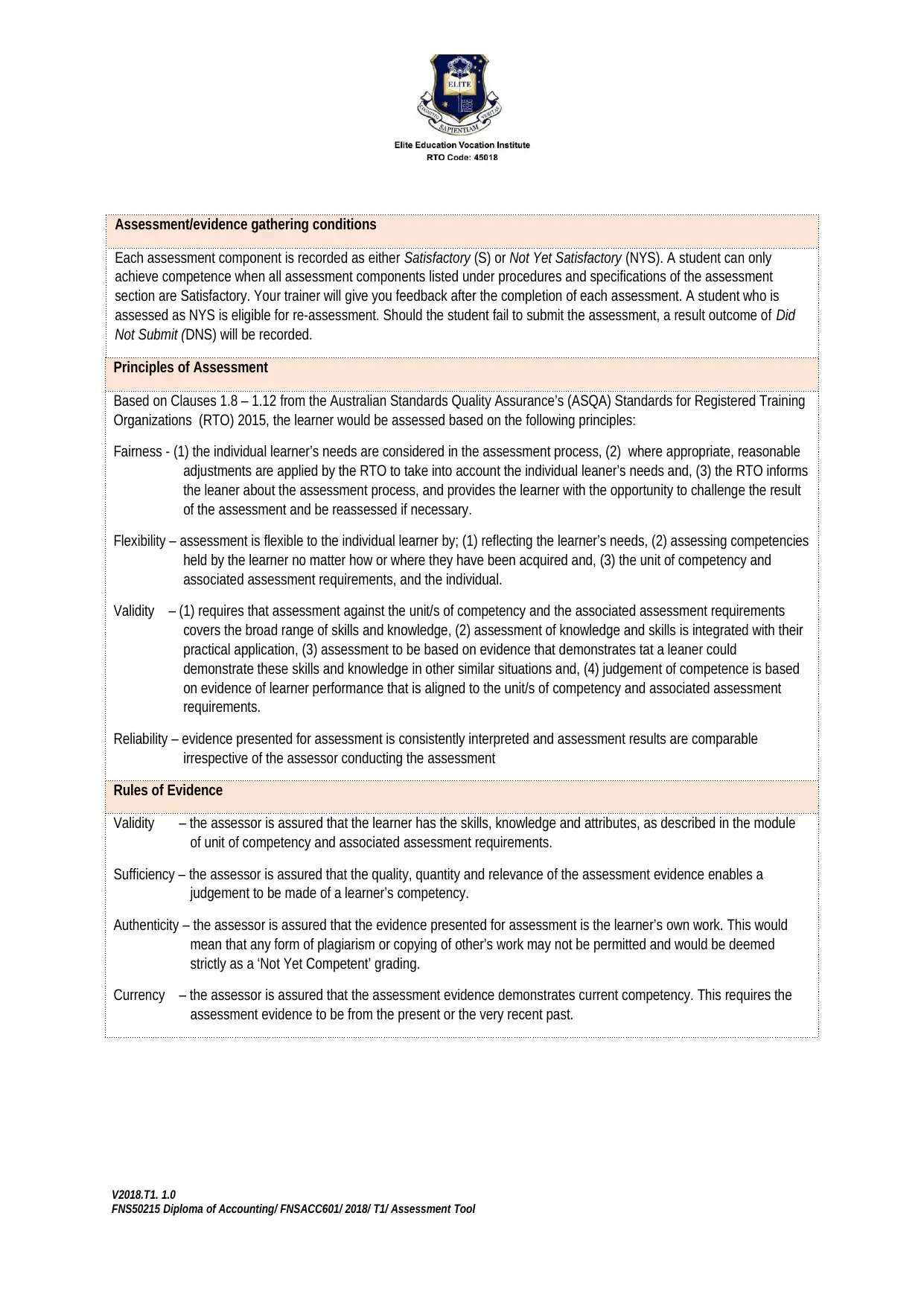
Assessment/evidence gathering conditions
Each assessment component is recorded as either Satisfactory (S) or Not Yet Satisfactory (NYS). A student can only
achieve competence when all assessment components listed under procedures and specifications of the assessment
section are Satisfactory. Your trainer will give you feedback after the completion of each assessment. A student who is
assessed as NYS is eligible for re-assessment. Should the student fail to submit the assessment, a result outcome of Did
Not Submit (DNS) will be recorded.
Principles of Assessment
Based on Clauses 1.8 – 1.12 from the Australian Standards Quality Assurance’s (ASQA) Standards for Registered Training
Organizations (RTO) 2015, the learner would be assessed based on the following principles:
Fairness - (1) the individual learner’s needs are considered in the assessment process, (2) where appropriate, reasonable
adjustments are applied by the RTO to take into account the individual leaner’s needs and, (3) the RTO informs
the leaner about the assessment process, and provides the learner with the opportunity to challenge the result
of the assessment and be reassessed if necessary.
Flexibility – assessment is flexible to the individual learner by; (1) reflecting the learner’s needs, (2) assessing competencies
held by the learner no matter how or where they have been acquired and, (3) the unit of competency and
associated assessment requirements, and the individual.
Validity – (1) requires that assessment against the unit/s of competency and the associated assessment requirements
covers the broad range of skills and knowledge, (2) assessment of knowledge and skills is integrated with their
practical application, (3) assessment to be based on evidence that demonstrates tat a leaner could
demonstrate these skills and knowledge in other similar situations and, (4) judgement of competence is based
on evidence of learner performance that is aligned to the unit/s of competency and associated assessment
requirements.
Reliability – evidence presented for assessment is consistently interpreted and assessment results are comparable
irrespective of the assessor conducting the assessment
Rules of Evidence
Validity – the assessor is assured that the learner has the skills, knowledge and attributes, as described in the module
of unit of competency and associated assessment requirements.
Sufficiency – the assessor is assured that the quality, quantity and relevance of the assessment evidence enables a
judgement to be made of a learner’s competency.
Authenticity – the assessor is assured that the evidence presented for assessment is the learner’s own work. This would
mean that any form of plagiarism or copying of other’s work may not be permitted and would be deemed
strictly as a ‘Not Yet Competent’ grading.
Currency – the assessor is assured that the assessment evidence demonstrates current competency. This requires the
assessment evidence to be from the present or the very recent past.
V2018.T1. 1.0
FNS50215 Diploma of Accounting/ FNSACC601/ 2018/ T1/ Assessment Tool
Each assessment component is recorded as either Satisfactory (S) or Not Yet Satisfactory (NYS). A student can only
achieve competence when all assessment components listed under procedures and specifications of the assessment
section are Satisfactory. Your trainer will give you feedback after the completion of each assessment. A student who is
assessed as NYS is eligible for re-assessment. Should the student fail to submit the assessment, a result outcome of Did
Not Submit (DNS) will be recorded.
Principles of Assessment
Based on Clauses 1.8 – 1.12 from the Australian Standards Quality Assurance’s (ASQA) Standards for Registered Training
Organizations (RTO) 2015, the learner would be assessed based on the following principles:
Fairness - (1) the individual learner’s needs are considered in the assessment process, (2) where appropriate, reasonable
adjustments are applied by the RTO to take into account the individual leaner’s needs and, (3) the RTO informs
the leaner about the assessment process, and provides the learner with the opportunity to challenge the result
of the assessment and be reassessed if necessary.
Flexibility – assessment is flexible to the individual learner by; (1) reflecting the learner’s needs, (2) assessing competencies
held by the learner no matter how or where they have been acquired and, (3) the unit of competency and
associated assessment requirements, and the individual.
Validity – (1) requires that assessment against the unit/s of competency and the associated assessment requirements
covers the broad range of skills and knowledge, (2) assessment of knowledge and skills is integrated with their
practical application, (3) assessment to be based on evidence that demonstrates tat a leaner could
demonstrate these skills and knowledge in other similar situations and, (4) judgement of competence is based
on evidence of learner performance that is aligned to the unit/s of competency and associated assessment
requirements.
Reliability – evidence presented for assessment is consistently interpreted and assessment results are comparable
irrespective of the assessor conducting the assessment
Rules of Evidence
Validity – the assessor is assured that the learner has the skills, knowledge and attributes, as described in the module
of unit of competency and associated assessment requirements.
Sufficiency – the assessor is assured that the quality, quantity and relevance of the assessment evidence enables a
judgement to be made of a learner’s competency.
Authenticity – the assessor is assured that the evidence presented for assessment is the learner’s own work. This would
mean that any form of plagiarism or copying of other’s work may not be permitted and would be deemed
strictly as a ‘Not Yet Competent’ grading.
Currency – the assessor is assured that the assessment evidence demonstrates current competency. This requires the
assessment evidence to be from the present or the very recent past.
V2018.T1. 1.0
FNS50215 Diploma of Accounting/ FNSACC601/ 2018/ T1/ Assessment Tool
⊘ This is a preview!⊘
Do you want full access?
Subscribe today to unlock all pages.

Trusted by 1+ million students worldwide
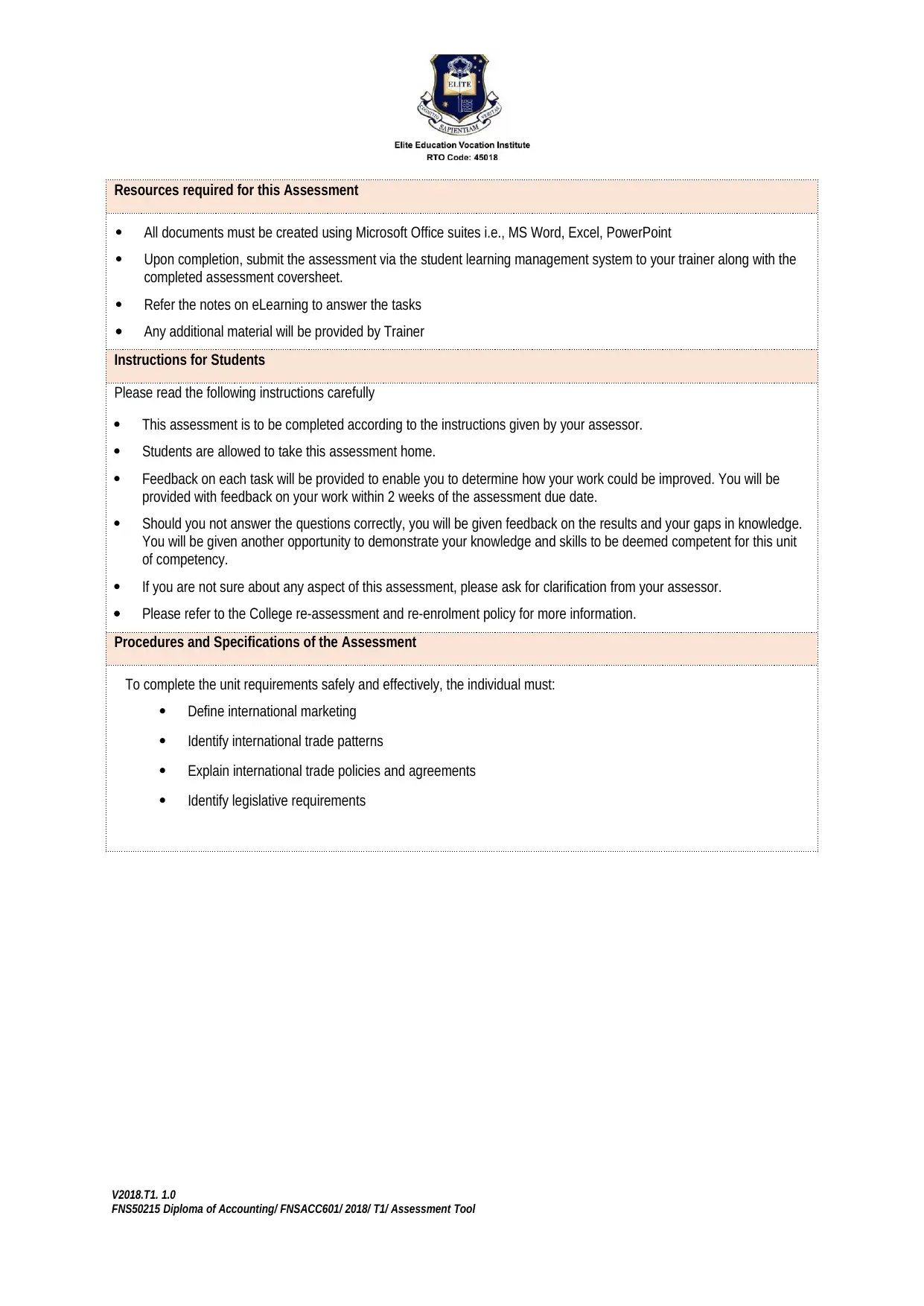
Resources required for this Assessment
All documents must be created using Microsoft Office suites i.e., MS Word, Excel, PowerPoint
Upon completion, submit the assessment via the student learning management system to your trainer along with the
completed assessment coversheet.
Refer the notes on eLearning to answer the tasks
Any additional material will be provided by Trainer
Instructions for Students
Please read the following instructions carefully
This assessment is to be completed according to the instructions given by your assessor.
Students are allowed to take this assessment home.
Feedback on each task will be provided to enable you to determine how your work could be improved. You will be
provided with feedback on your work within 2 weeks of the assessment due date.
Should you not answer the questions correctly, you will be given feedback on the results and your gaps in knowledge.
You will be given another opportunity to demonstrate your knowledge and skills to be deemed competent for this unit
of competency.
If you are not sure about any aspect of this assessment, please ask for clarification from your assessor.
Please refer to the College re-assessment and re-enrolment policy for more information.
Procedures and Specifications of the Assessment
To complete the unit requirements safely and effectively, the individual must:
Define international marketing
Identify international trade patterns
Explain international trade policies and agreements
Identify legislative requirements
V2018.T1. 1.0
FNS50215 Diploma of Accounting/ FNSACC601/ 2018/ T1/ Assessment Tool
All documents must be created using Microsoft Office suites i.e., MS Word, Excel, PowerPoint
Upon completion, submit the assessment via the student learning management system to your trainer along with the
completed assessment coversheet.
Refer the notes on eLearning to answer the tasks
Any additional material will be provided by Trainer
Instructions for Students
Please read the following instructions carefully
This assessment is to be completed according to the instructions given by your assessor.
Students are allowed to take this assessment home.
Feedback on each task will be provided to enable you to determine how your work could be improved. You will be
provided with feedback on your work within 2 weeks of the assessment due date.
Should you not answer the questions correctly, you will be given feedback on the results and your gaps in knowledge.
You will be given another opportunity to demonstrate your knowledge and skills to be deemed competent for this unit
of competency.
If you are not sure about any aspect of this assessment, please ask for clarification from your assessor.
Please refer to the College re-assessment and re-enrolment policy for more information.
Procedures and Specifications of the Assessment
To complete the unit requirements safely and effectively, the individual must:
Define international marketing
Identify international trade patterns
Explain international trade policies and agreements
Identify legislative requirements
V2018.T1. 1.0
FNS50215 Diploma of Accounting/ FNSACC601/ 2018/ T1/ Assessment Tool
Paraphrase This Document
Need a fresh take? Get an instant paraphrase of this document with our AI Paraphraser
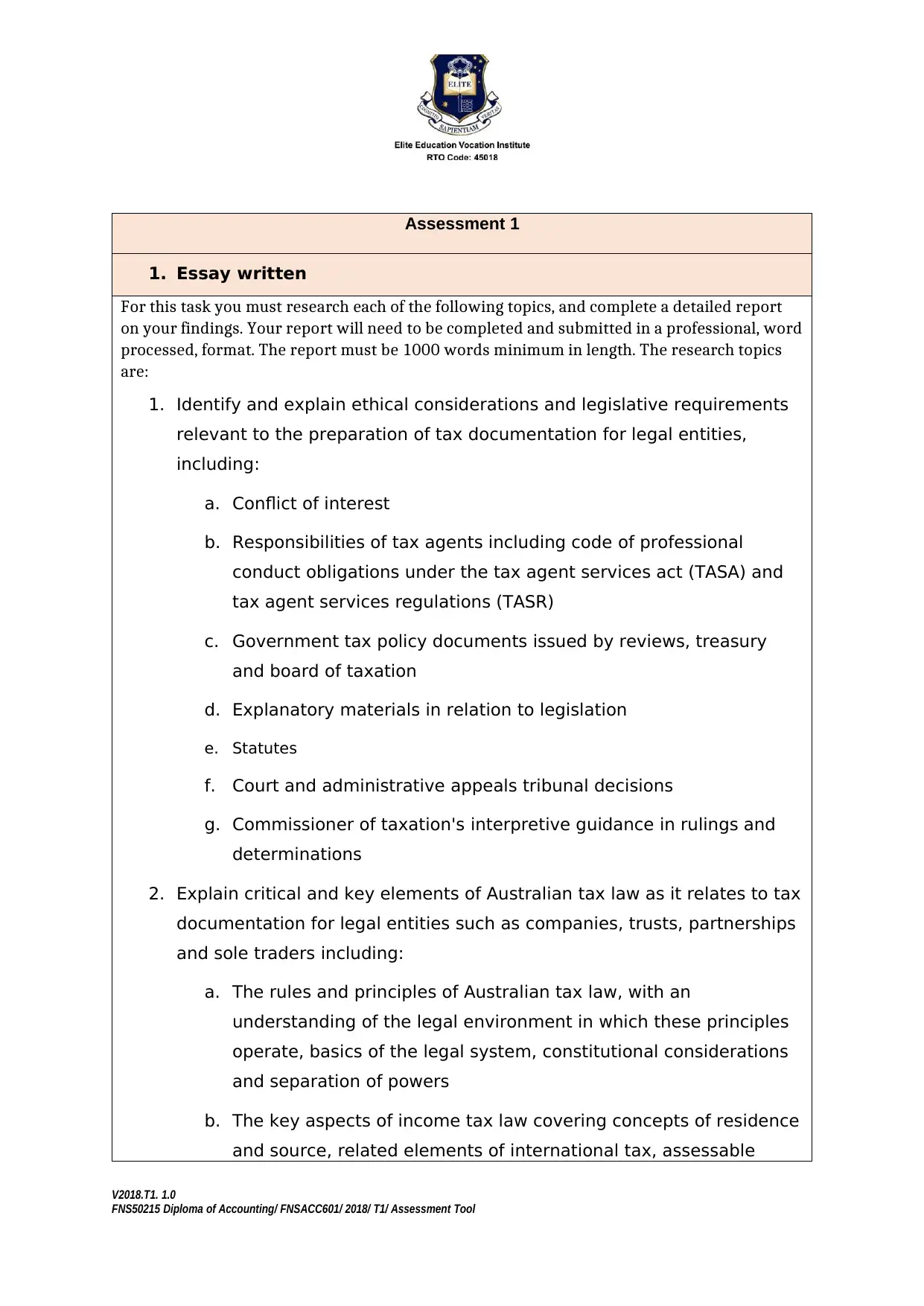
Assessment 1
1. Essay written
For this task you must research each of the following topics, and complete a detailed report
on your findings. Your report will need to be completed and submitted in a professional, word
processed, format. The report must be 1000 words minimum in length. The research topics
are:
1. Identify and explain ethical considerations and legislative requirements
relevant to the preparation of tax documentation for legal entities,
including:
a. Conflict of interest
b. Responsibilities of tax agents including code of professional
conduct obligations under the tax agent services act (TASA) and
tax agent services regulations (TASR)
c. Government tax policy documents issued by reviews, treasury
and board of taxation
d. Explanatory materials in relation to legislation
e. Statutes
f. Court and administrative appeals tribunal decisions
g. Commissioner of taxation's interpretive guidance in rulings and
determinations
2. Explain critical and key elements of Australian tax law as it relates to tax
documentation for legal entities such as companies, trusts, partnerships
and sole traders including:
a. The rules and principles of Australian tax law, with an
understanding of the legal environment in which these principles
operate, basics of the legal system, constitutional considerations
and separation of powers
b. The key aspects of income tax law covering concepts of residence
and source, related elements of international tax, assessable
V2018.T1. 1.0
FNS50215 Diploma of Accounting/ FNSACC601/ 2018/ T1/ Assessment Tool
1. Essay written
For this task you must research each of the following topics, and complete a detailed report
on your findings. Your report will need to be completed and submitted in a professional, word
processed, format. The report must be 1000 words minimum in length. The research topics
are:
1. Identify and explain ethical considerations and legislative requirements
relevant to the preparation of tax documentation for legal entities,
including:
a. Conflict of interest
b. Responsibilities of tax agents including code of professional
conduct obligations under the tax agent services act (TASA) and
tax agent services regulations (TASR)
c. Government tax policy documents issued by reviews, treasury
and board of taxation
d. Explanatory materials in relation to legislation
e. Statutes
f. Court and administrative appeals tribunal decisions
g. Commissioner of taxation's interpretive guidance in rulings and
determinations
2. Explain critical and key elements of Australian tax law as it relates to tax
documentation for legal entities such as companies, trusts, partnerships
and sole traders including:
a. The rules and principles of Australian tax law, with an
understanding of the legal environment in which these principles
operate, basics of the legal system, constitutional considerations
and separation of powers
b. The key aspects of income tax law covering concepts of residence
and source, related elements of international tax, assessable
V2018.T1. 1.0
FNS50215 Diploma of Accounting/ FNSACC601/ 2018/ T1/ Assessment Tool
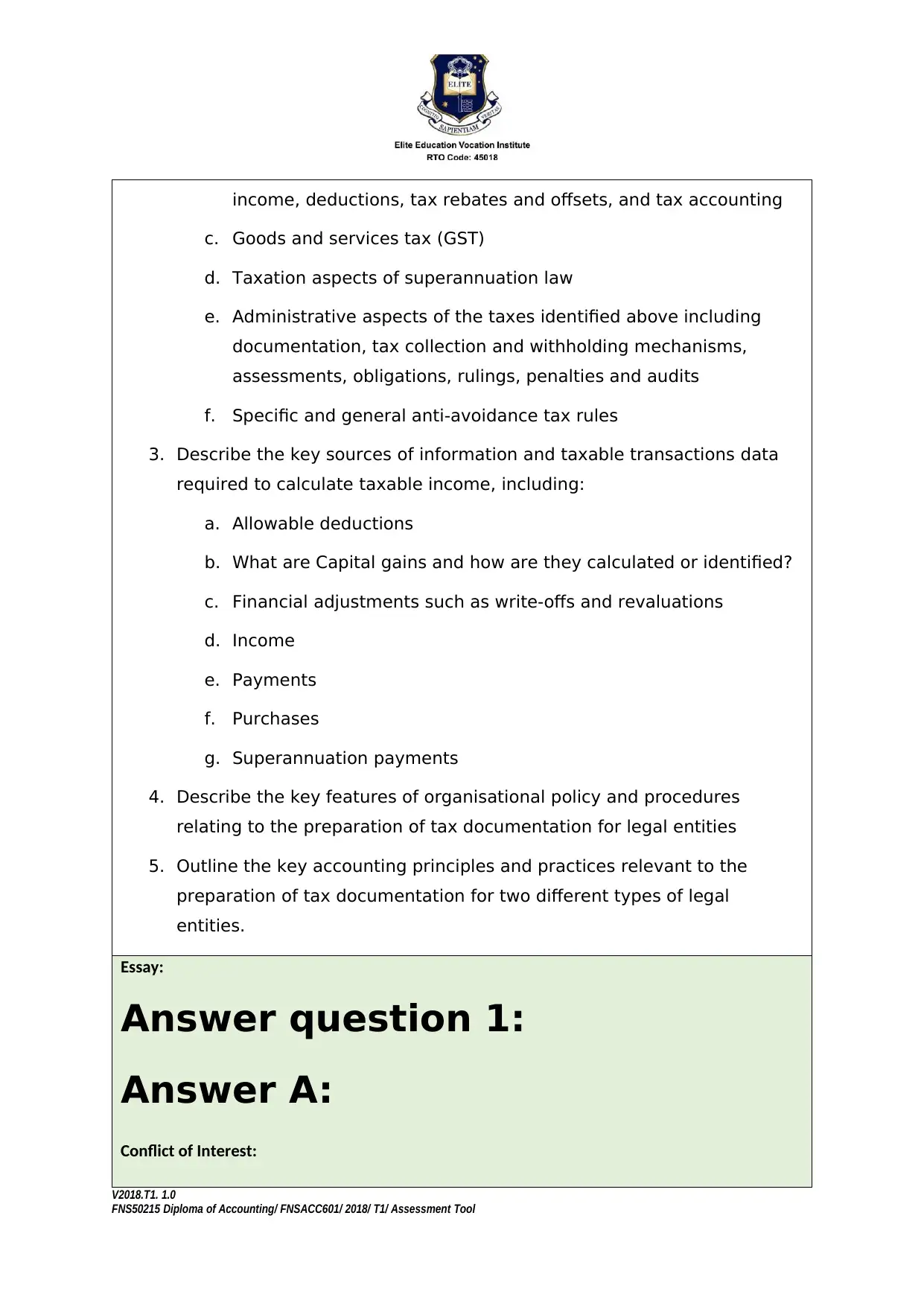
income, deductions, tax rebates and offsets, and tax accounting
c. Goods and services tax (GST)
d. Taxation aspects of superannuation law
e. Administrative aspects of the taxes identified above including
documentation, tax collection and withholding mechanisms,
assessments, obligations, rulings, penalties and audits
f. Specific and general anti-avoidance tax rules
3. Describe the key sources of information and taxable transactions data
required to calculate taxable income, including:
a. Allowable deductions
b. What are Capital gains and how are they calculated or identified?
c. Financial adjustments such as write-offs and revaluations
d. Income
e. Payments
f. Purchases
g. Superannuation payments
4. Describe the key features of organisational policy and procedures
relating to the preparation of tax documentation for legal entities
5. Outline the key accounting principles and practices relevant to the
preparation of tax documentation for two different types of legal
entities.
Essay:
Answer question 1:
Answer A:
Conflict of Interest:
V2018.T1. 1.0
FNS50215 Diploma of Accounting/ FNSACC601/ 2018/ T1/ Assessment Tool
c. Goods and services tax (GST)
d. Taxation aspects of superannuation law
e. Administrative aspects of the taxes identified above including
documentation, tax collection and withholding mechanisms,
assessments, obligations, rulings, penalties and audits
f. Specific and general anti-avoidance tax rules
3. Describe the key sources of information and taxable transactions data
required to calculate taxable income, including:
a. Allowable deductions
b. What are Capital gains and how are they calculated or identified?
c. Financial adjustments such as write-offs and revaluations
d. Income
e. Payments
f. Purchases
g. Superannuation payments
4. Describe the key features of organisational policy and procedures
relating to the preparation of tax documentation for legal entities
5. Outline the key accounting principles and practices relevant to the
preparation of tax documentation for two different types of legal
entities.
Essay:
Answer question 1:
Answer A:
Conflict of Interest:
V2018.T1. 1.0
FNS50215 Diploma of Accounting/ FNSACC601/ 2018/ T1/ Assessment Tool
⊘ This is a preview!⊘
Do you want full access?
Subscribe today to unlock all pages.

Trusted by 1+ million students worldwide
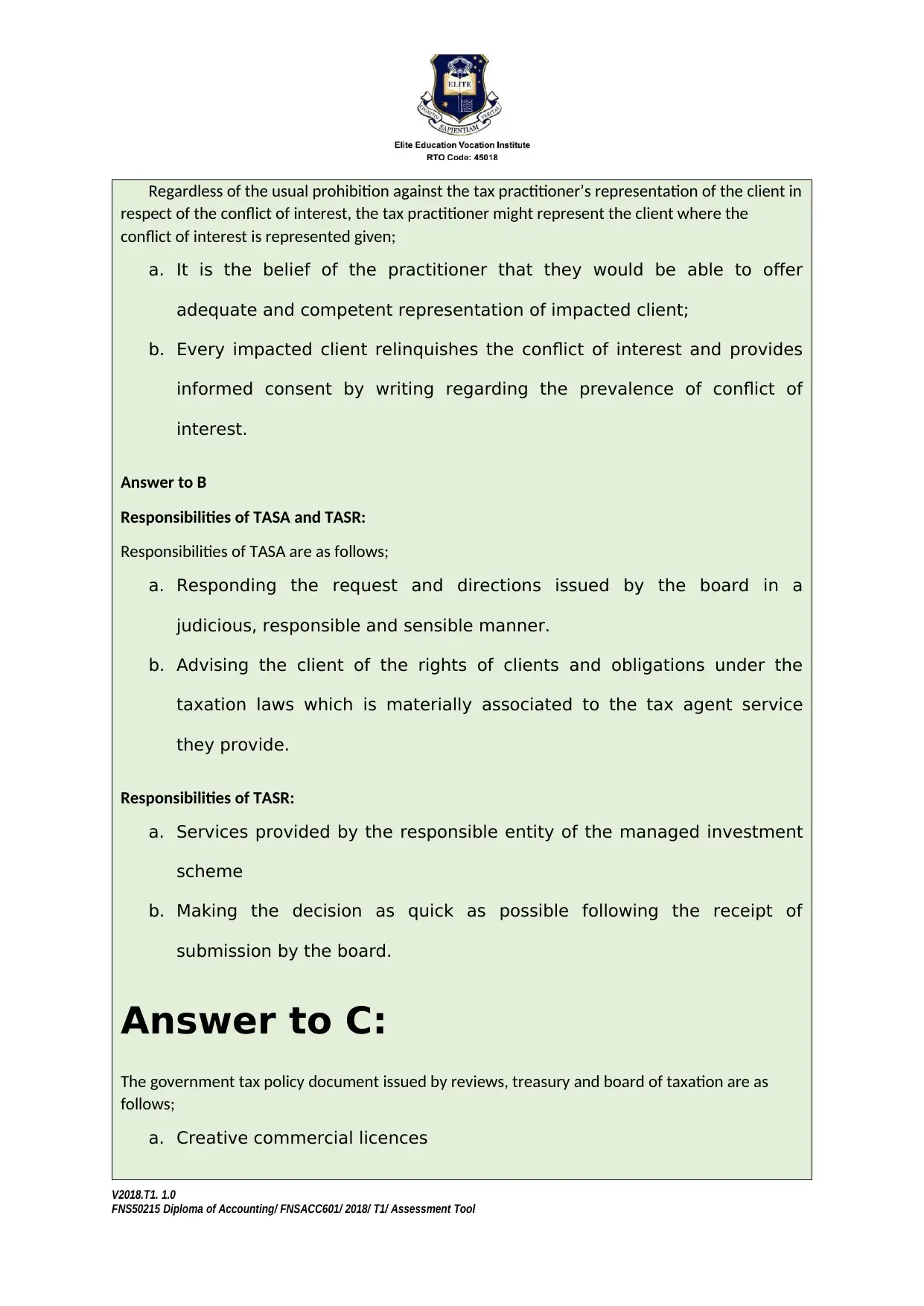
Regardless of the usual prohibition against the tax practitioner’s representation of the client in
respect of the conflict of interest, the tax practitioner might represent the client where the
conflict of interest is represented given;
a. It is the belief of the practitioner that they would be able to offer
adequate and competent representation of impacted client;
b. Every impacted client relinquishes the conflict of interest and provides
informed consent by writing regarding the prevalence of conflict of
interest.
Answer to B
Responsibilities of TASA and TASR:
Responsibilities of TASA are as follows;
a. Responding the request and directions issued by the board in a
judicious, responsible and sensible manner.
b. Advising the client of the rights of clients and obligations under the
taxation laws which is materially associated to the tax agent service
they provide.
Responsibilities of TASR:
a. Services provided by the responsible entity of the managed investment
scheme
b. Making the decision as quick as possible following the receipt of
submission by the board.
Answer to C:
The government tax policy document issued by reviews, treasury and board of taxation are as
follows;
a. Creative commercial licences
V2018.T1. 1.0
FNS50215 Diploma of Accounting/ FNSACC601/ 2018/ T1/ Assessment Tool
respect of the conflict of interest, the tax practitioner might represent the client where the
conflict of interest is represented given;
a. It is the belief of the practitioner that they would be able to offer
adequate and competent representation of impacted client;
b. Every impacted client relinquishes the conflict of interest and provides
informed consent by writing regarding the prevalence of conflict of
interest.
Answer to B
Responsibilities of TASA and TASR:
Responsibilities of TASA are as follows;
a. Responding the request and directions issued by the board in a
judicious, responsible and sensible manner.
b. Advising the client of the rights of clients and obligations under the
taxation laws which is materially associated to the tax agent service
they provide.
Responsibilities of TASR:
a. Services provided by the responsible entity of the managed investment
scheme
b. Making the decision as quick as possible following the receipt of
submission by the board.
Answer to C:
The government tax policy document issued by reviews, treasury and board of taxation are as
follows;
a. Creative commercial licences
V2018.T1. 1.0
FNS50215 Diploma of Accounting/ FNSACC601/ 2018/ T1/ Assessment Tool
Paraphrase This Document
Need a fresh take? Get an instant paraphrase of this document with our AI Paraphraser
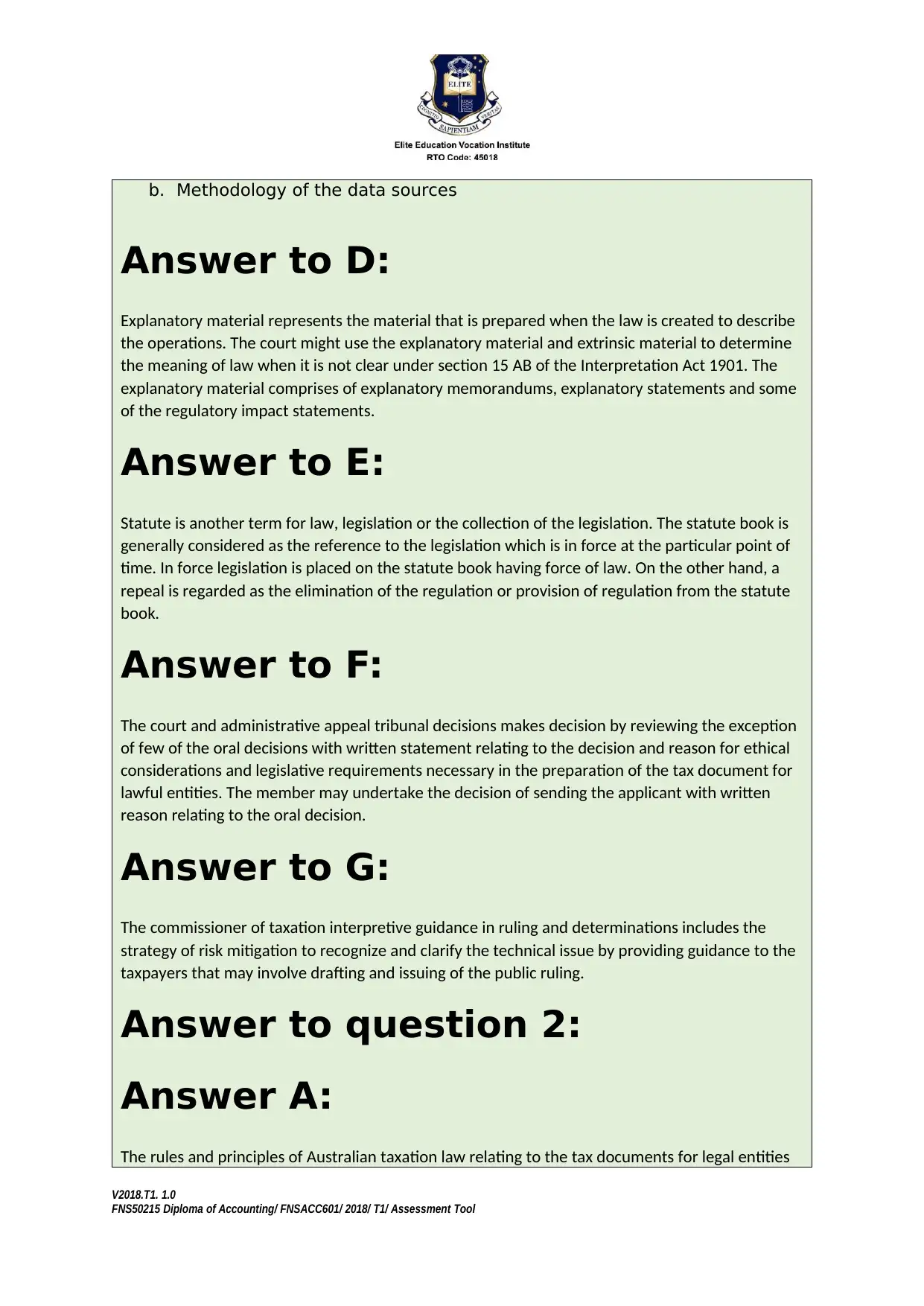
b. Methodology of the data sources
Answer to D:
Explanatory material represents the material that is prepared when the law is created to describe
the operations. The court might use the explanatory material and extrinsic material to determine
the meaning of law when it is not clear under section 15 AB of the Interpretation Act 1901. The
explanatory material comprises of explanatory memorandums, explanatory statements and some
of the regulatory impact statements.
Answer to E:
Statute is another term for law, legislation or the collection of the legislation. The statute book is
generally considered as the reference to the legislation which is in force at the particular point of
time. In force legislation is placed on the statute book having force of law. On the other hand, a
repeal is regarded as the elimination of the regulation or provision of regulation from the statute
book.
Answer to F:
The court and administrative appeal tribunal decisions makes decision by reviewing the exception
of few of the oral decisions with written statement relating to the decision and reason for ethical
considerations and legislative requirements necessary in the preparation of the tax document for
lawful entities. The member may undertake the decision of sending the applicant with written
reason relating to the oral decision.
Answer to G:
The commissioner of taxation interpretive guidance in ruling and determinations includes the
strategy of risk mitigation to recognize and clarify the technical issue by providing guidance to the
taxpayers that may involve drafting and issuing of the public ruling.
Answer to question 2:
Answer A:
The rules and principles of Australian taxation law relating to the tax documents for legal entities
V2018.T1. 1.0
FNS50215 Diploma of Accounting/ FNSACC601/ 2018/ T1/ Assessment Tool
Answer to D:
Explanatory material represents the material that is prepared when the law is created to describe
the operations. The court might use the explanatory material and extrinsic material to determine
the meaning of law when it is not clear under section 15 AB of the Interpretation Act 1901. The
explanatory material comprises of explanatory memorandums, explanatory statements and some
of the regulatory impact statements.
Answer to E:
Statute is another term for law, legislation or the collection of the legislation. The statute book is
generally considered as the reference to the legislation which is in force at the particular point of
time. In force legislation is placed on the statute book having force of law. On the other hand, a
repeal is regarded as the elimination of the regulation or provision of regulation from the statute
book.
Answer to F:
The court and administrative appeal tribunal decisions makes decision by reviewing the exception
of few of the oral decisions with written statement relating to the decision and reason for ethical
considerations and legislative requirements necessary in the preparation of the tax document for
lawful entities. The member may undertake the decision of sending the applicant with written
reason relating to the oral decision.
Answer to G:
The commissioner of taxation interpretive guidance in ruling and determinations includes the
strategy of risk mitigation to recognize and clarify the technical issue by providing guidance to the
taxpayers that may involve drafting and issuing of the public ruling.
Answer to question 2:
Answer A:
The rules and principles of Australian taxation law relating to the tax documents for legal entities
V2018.T1. 1.0
FNS50215 Diploma of Accounting/ FNSACC601/ 2018/ T1/ Assessment Tool
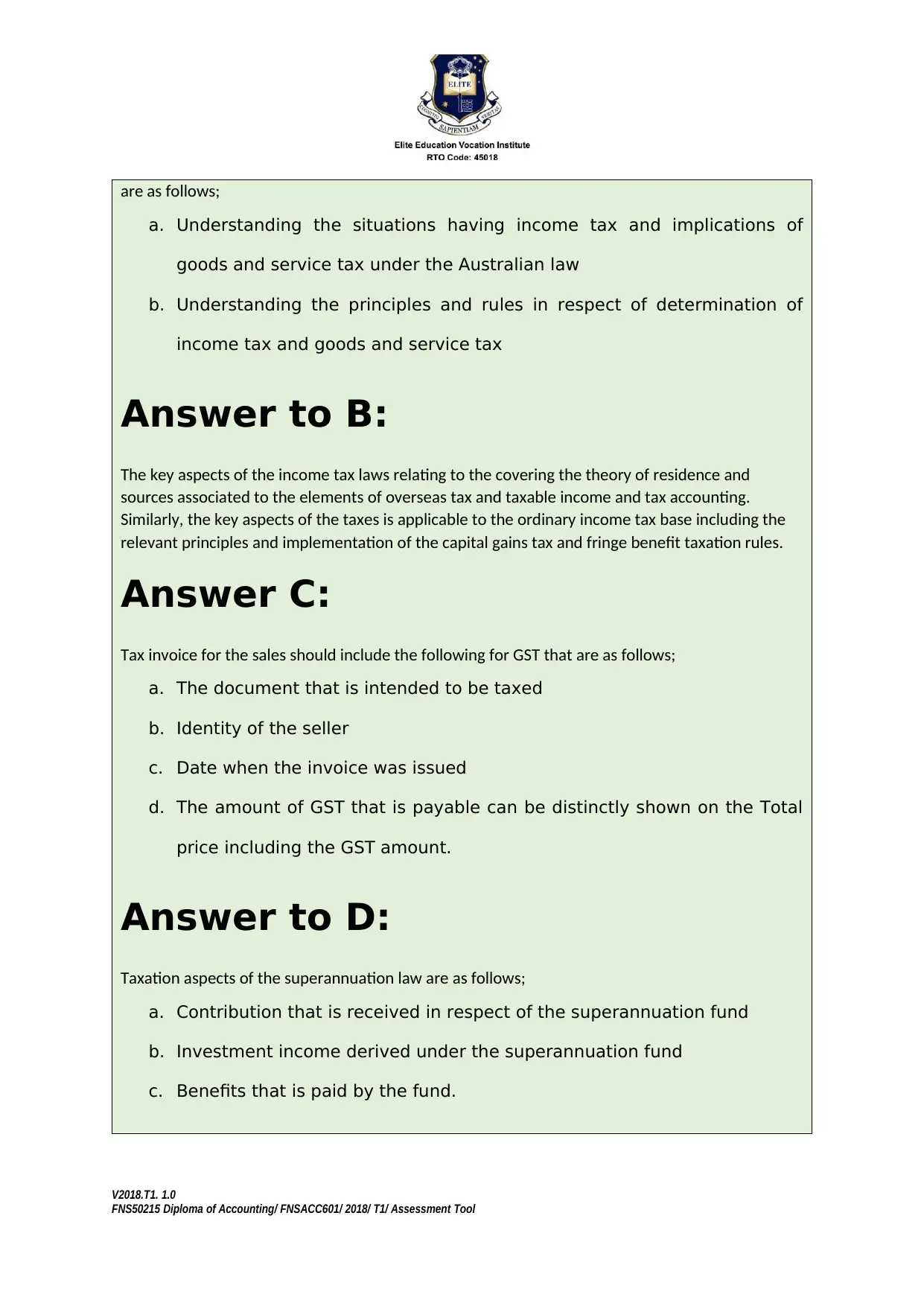
are as follows;
a. Understanding the situations having income tax and implications of
goods and service tax under the Australian law
b. Understanding the principles and rules in respect of determination of
income tax and goods and service tax
Answer to B:
The key aspects of the income tax laws relating to the covering the theory of residence and
sources associated to the elements of overseas tax and taxable income and tax accounting.
Similarly, the key aspects of the taxes is applicable to the ordinary income tax base including the
relevant principles and implementation of the capital gains tax and fringe benefit taxation rules.
Answer C:
Tax invoice for the sales should include the following for GST that are as follows;
a. The document that is intended to be taxed
b. Identity of the seller
c. Date when the invoice was issued
d. The amount of GST that is payable can be distinctly shown on the Total
price including the GST amount.
Answer to D:
Taxation aspects of the superannuation law are as follows;
a. Contribution that is received in respect of the superannuation fund
b. Investment income derived under the superannuation fund
c. Benefits that is paid by the fund.
V2018.T1. 1.0
FNS50215 Diploma of Accounting/ FNSACC601/ 2018/ T1/ Assessment Tool
a. Understanding the situations having income tax and implications of
goods and service tax under the Australian law
b. Understanding the principles and rules in respect of determination of
income tax and goods and service tax
Answer to B:
The key aspects of the income tax laws relating to the covering the theory of residence and
sources associated to the elements of overseas tax and taxable income and tax accounting.
Similarly, the key aspects of the taxes is applicable to the ordinary income tax base including the
relevant principles and implementation of the capital gains tax and fringe benefit taxation rules.
Answer C:
Tax invoice for the sales should include the following for GST that are as follows;
a. The document that is intended to be taxed
b. Identity of the seller
c. Date when the invoice was issued
d. The amount of GST that is payable can be distinctly shown on the Total
price including the GST amount.
Answer to D:
Taxation aspects of the superannuation law are as follows;
a. Contribution that is received in respect of the superannuation fund
b. Investment income derived under the superannuation fund
c. Benefits that is paid by the fund.
V2018.T1. 1.0
FNS50215 Diploma of Accounting/ FNSACC601/ 2018/ T1/ Assessment Tool
⊘ This is a preview!⊘
Do you want full access?
Subscribe today to unlock all pages.

Trusted by 1+ million students worldwide
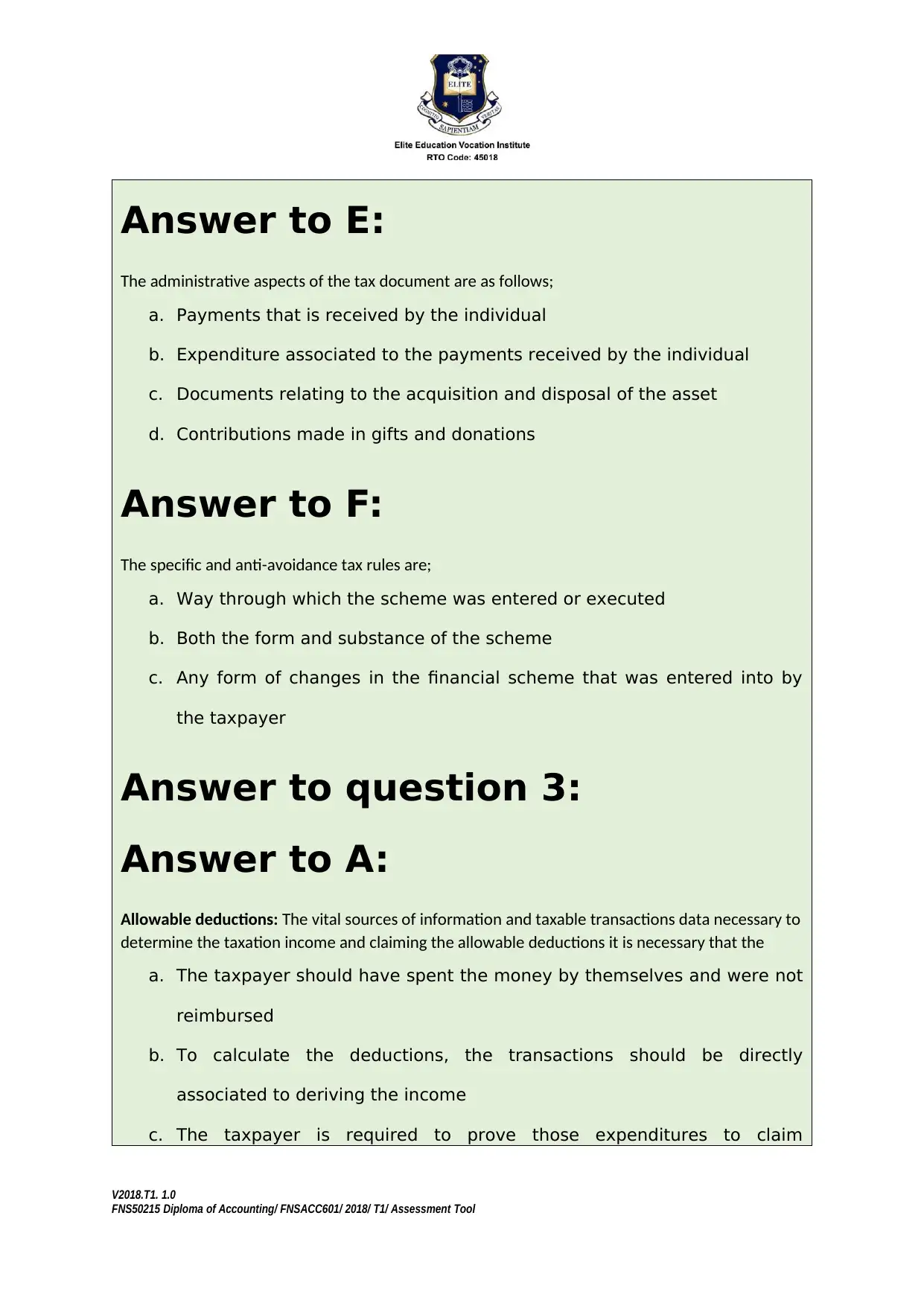
Answer to E:
The administrative aspects of the tax document are as follows;
a. Payments that is received by the individual
b. Expenditure associated to the payments received by the individual
c. Documents relating to the acquisition and disposal of the asset
d. Contributions made in gifts and donations
Answer to F:
The specific and anti-avoidance tax rules are;
a. Way through which the scheme was entered or executed
b. Both the form and substance of the scheme
c. Any form of changes in the financial scheme that was entered into by
the taxpayer
Answer to question 3:
Answer to A:
Allowable deductions: The vital sources of information and taxable transactions data necessary to
determine the taxation income and claiming the allowable deductions it is necessary that the
a. The taxpayer should have spent the money by themselves and were not
reimbursed
b. To calculate the deductions, the transactions should be directly
associated to deriving the income
c. The taxpayer is required to prove those expenditures to claim
V2018.T1. 1.0
FNS50215 Diploma of Accounting/ FNSACC601/ 2018/ T1/ Assessment Tool
The administrative aspects of the tax document are as follows;
a. Payments that is received by the individual
b. Expenditure associated to the payments received by the individual
c. Documents relating to the acquisition and disposal of the asset
d. Contributions made in gifts and donations
Answer to F:
The specific and anti-avoidance tax rules are;
a. Way through which the scheme was entered or executed
b. Both the form and substance of the scheme
c. Any form of changes in the financial scheme that was entered into by
the taxpayer
Answer to question 3:
Answer to A:
Allowable deductions: The vital sources of information and taxable transactions data necessary to
determine the taxation income and claiming the allowable deductions it is necessary that the
a. The taxpayer should have spent the money by themselves and were not
reimbursed
b. To calculate the deductions, the transactions should be directly
associated to deriving the income
c. The taxpayer is required to prove those expenditures to claim
V2018.T1. 1.0
FNS50215 Diploma of Accounting/ FNSACC601/ 2018/ T1/ Assessment Tool
Paraphrase This Document
Need a fresh take? Get an instant paraphrase of this document with our AI Paraphraser
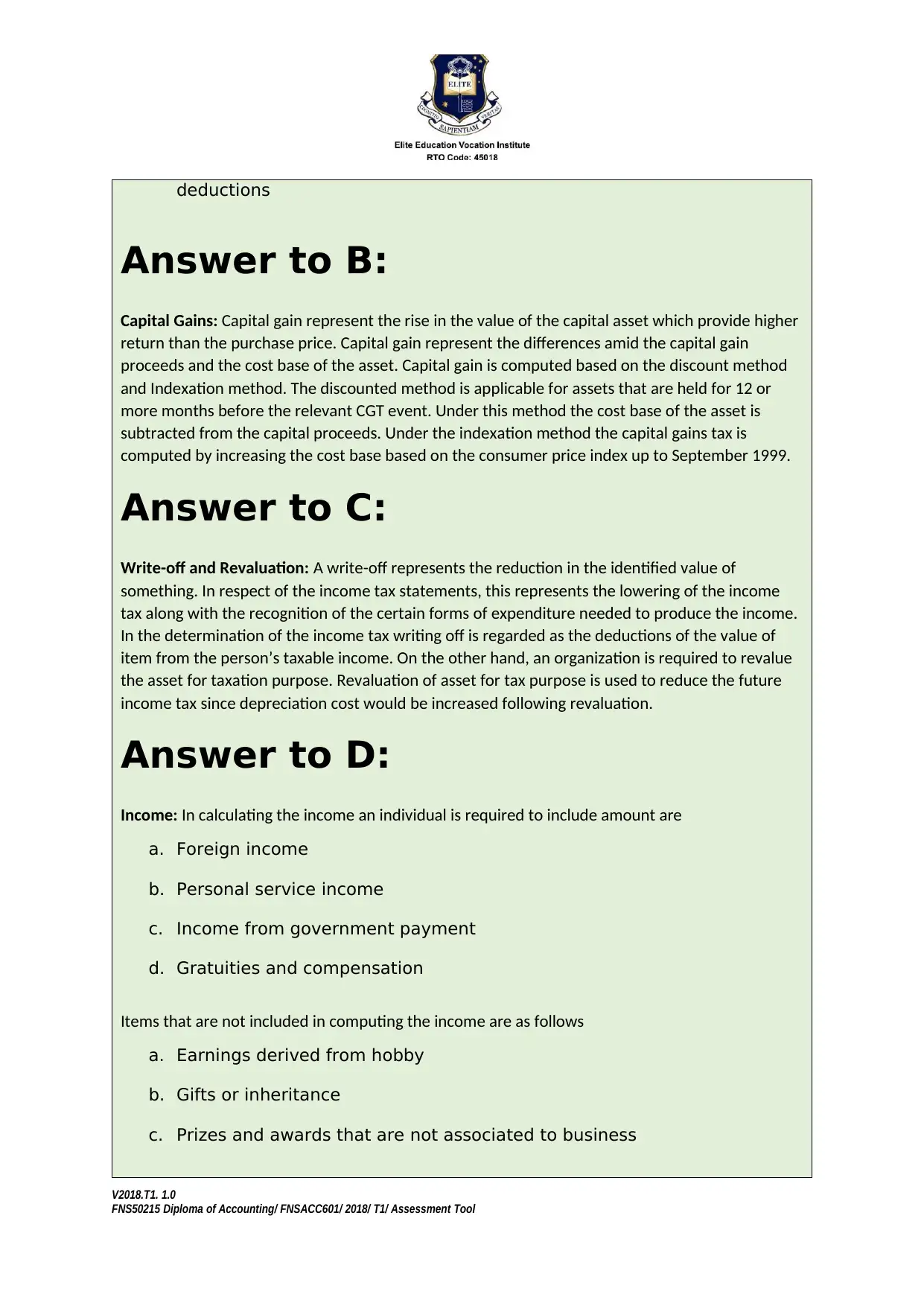
deductions
Answer to B:
Capital Gains: Capital gain represent the rise in the value of the capital asset which provide higher
return than the purchase price. Capital gain represent the differences amid the capital gain
proceeds and the cost base of the asset. Capital gain is computed based on the discount method
and Indexation method. The discounted method is applicable for assets that are held for 12 or
more months before the relevant CGT event. Under this method the cost base of the asset is
subtracted from the capital proceeds. Under the indexation method the capital gains tax is
computed by increasing the cost base based on the consumer price index up to September 1999.
Answer to C:
Write-off and Revaluation: A write-off represents the reduction in the identified value of
something. In respect of the income tax statements, this represents the lowering of the income
tax along with the recognition of the certain forms of expenditure needed to produce the income.
In the determination of the income tax writing off is regarded as the deductions of the value of
item from the person’s taxable income. On the other hand, an organization is required to revalue
the asset for taxation purpose. Revaluation of asset for tax purpose is used to reduce the future
income tax since depreciation cost would be increased following revaluation.
Answer to D:
Income: In calculating the income an individual is required to include amount are
a. Foreign income
b. Personal service income
c. Income from government payment
d. Gratuities and compensation
Items that are not included in computing the income are as follows
a. Earnings derived from hobby
b. Gifts or inheritance
c. Prizes and awards that are not associated to business
V2018.T1. 1.0
FNS50215 Diploma of Accounting/ FNSACC601/ 2018/ T1/ Assessment Tool
Answer to B:
Capital Gains: Capital gain represent the rise in the value of the capital asset which provide higher
return than the purchase price. Capital gain represent the differences amid the capital gain
proceeds and the cost base of the asset. Capital gain is computed based on the discount method
and Indexation method. The discounted method is applicable for assets that are held for 12 or
more months before the relevant CGT event. Under this method the cost base of the asset is
subtracted from the capital proceeds. Under the indexation method the capital gains tax is
computed by increasing the cost base based on the consumer price index up to September 1999.
Answer to C:
Write-off and Revaluation: A write-off represents the reduction in the identified value of
something. In respect of the income tax statements, this represents the lowering of the income
tax along with the recognition of the certain forms of expenditure needed to produce the income.
In the determination of the income tax writing off is regarded as the deductions of the value of
item from the person’s taxable income. On the other hand, an organization is required to revalue
the asset for taxation purpose. Revaluation of asset for tax purpose is used to reduce the future
income tax since depreciation cost would be increased following revaluation.
Answer to D:
Income: In calculating the income an individual is required to include amount are
a. Foreign income
b. Personal service income
c. Income from government payment
d. Gratuities and compensation
Items that are not included in computing the income are as follows
a. Earnings derived from hobby
b. Gifts or inheritance
c. Prizes and awards that are not associated to business
V2018.T1. 1.0
FNS50215 Diploma of Accounting/ FNSACC601/ 2018/ T1/ Assessment Tool
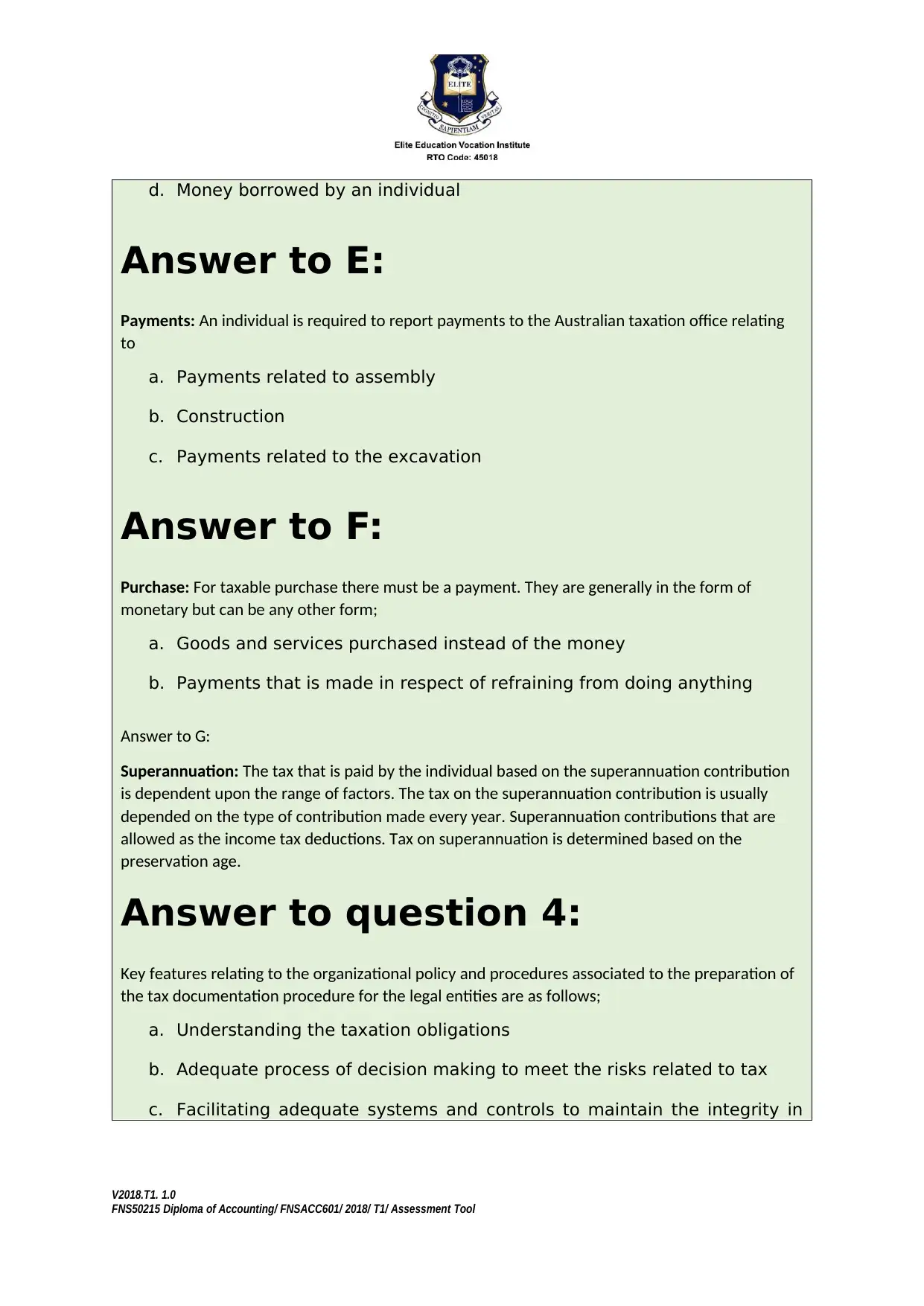
d. Money borrowed by an individual
Answer to E:
Payments: An individual is required to report payments to the Australian taxation office relating
to
a. Payments related to assembly
b. Construction
c. Payments related to the excavation
Answer to F:
Purchase: For taxable purchase there must be a payment. They are generally in the form of
monetary but can be any other form;
a. Goods and services purchased instead of the money
b. Payments that is made in respect of refraining from doing anything
Answer to G:
Superannuation: The tax that is paid by the individual based on the superannuation contribution
is dependent upon the range of factors. The tax on the superannuation contribution is usually
depended on the type of contribution made every year. Superannuation contributions that are
allowed as the income tax deductions. Tax on superannuation is determined based on the
preservation age.
Answer to question 4:
Key features relating to the organizational policy and procedures associated to the preparation of
the tax documentation procedure for the legal entities are as follows;
a. Understanding the taxation obligations
b. Adequate process of decision making to meet the risks related to tax
c. Facilitating adequate systems and controls to maintain the integrity in
V2018.T1. 1.0
FNS50215 Diploma of Accounting/ FNSACC601/ 2018/ T1/ Assessment Tool
Answer to E:
Payments: An individual is required to report payments to the Australian taxation office relating
to
a. Payments related to assembly
b. Construction
c. Payments related to the excavation
Answer to F:
Purchase: For taxable purchase there must be a payment. They are generally in the form of
monetary but can be any other form;
a. Goods and services purchased instead of the money
b. Payments that is made in respect of refraining from doing anything
Answer to G:
Superannuation: The tax that is paid by the individual based on the superannuation contribution
is dependent upon the range of factors. The tax on the superannuation contribution is usually
depended on the type of contribution made every year. Superannuation contributions that are
allowed as the income tax deductions. Tax on superannuation is determined based on the
preservation age.
Answer to question 4:
Key features relating to the organizational policy and procedures associated to the preparation of
the tax documentation procedure for the legal entities are as follows;
a. Understanding the taxation obligations
b. Adequate process of decision making to meet the risks related to tax
c. Facilitating adequate systems and controls to maintain the integrity in
V2018.T1. 1.0
FNS50215 Diploma of Accounting/ FNSACC601/ 2018/ T1/ Assessment Tool
⊘ This is a preview!⊘
Do you want full access?
Subscribe today to unlock all pages.

Trusted by 1+ million students worldwide
1 out of 21
Related Documents
Your All-in-One AI-Powered Toolkit for Academic Success.
+13062052269
info@desklib.com
Available 24*7 on WhatsApp / Email
![[object Object]](/_next/static/media/star-bottom.7253800d.svg)
Unlock your academic potential
Copyright © 2020–2025 A2Z Services. All Rights Reserved. Developed and managed by ZUCOL.





